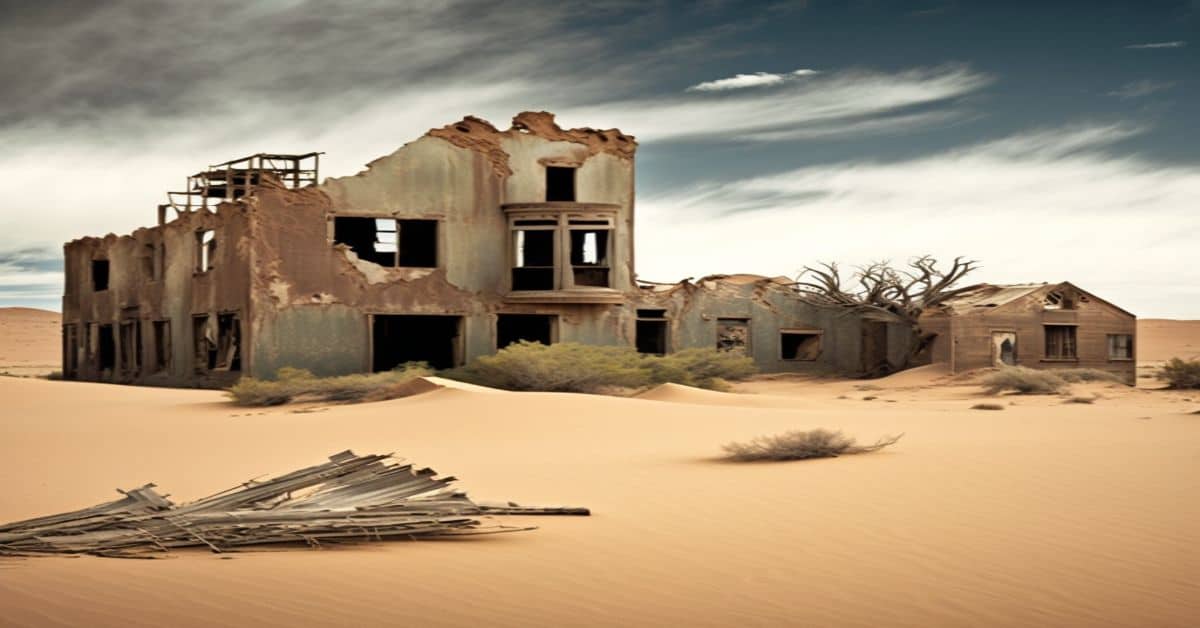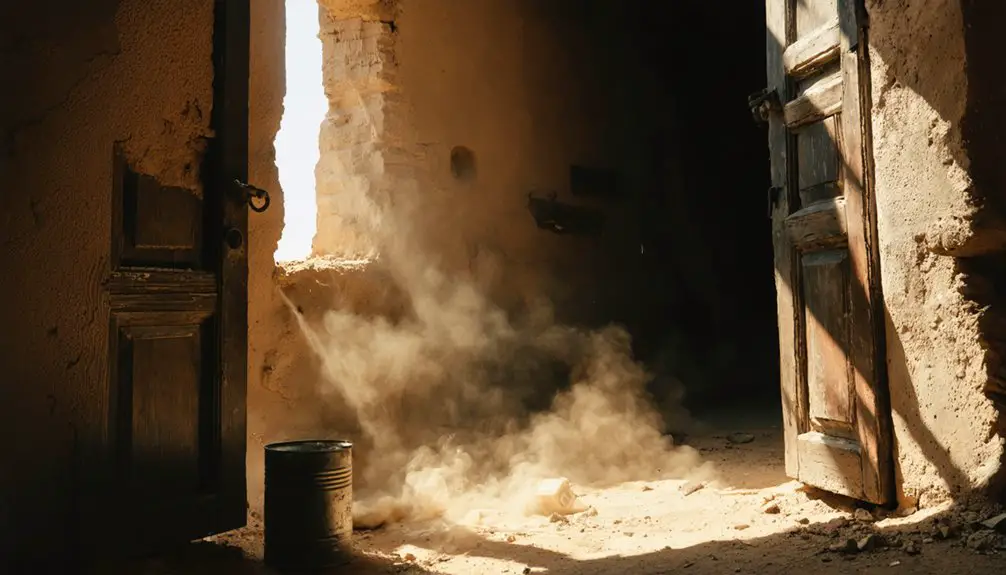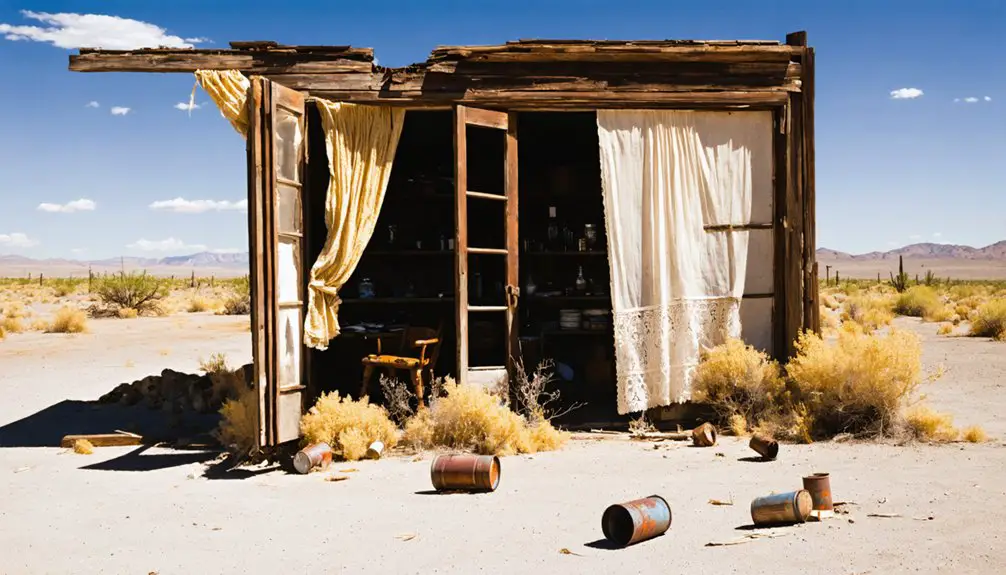With a population of over 2 million, New Mexico has an astonishing number of ghost towns.
There are an estimated 578 ghost towns in New Mexico. Of those 578 or more ghost towns, only a select few can be recognized and explored. Most of New Mexico’s ghost towns are barren and lost to the land.
Knowing most of New Mexico’s ghost towns are just a piece of history that developed the state, some ghost towns seem frozen in time.
Chloride, New Mexico
Located in the southwestern county of Sierra, Chloride started as a mining community after chlorargyrite was found in the banks along a stream. Chlorargyrite is also silver chloride, giving the community an easy name to remember. Chloride grew large enough a post office was established and continued operating until its final days in 1956.
Chloride, New Mexico, witnessed a tremendous economic boost in the 1880s after Harry Pye, a mule skinner and prospector, discovered silver while delivering fright for the U.S. Army in 1879. Once Pye’s delivery contract was completed with the Army in 1881, he and two other individuals staked a claim in the land where the silver was first found.
The initial tent city was named Pyetown to honor Harry Pye, then changed to Bromide, and finally ended with the name Chloride, related to the silver chloride being mined. Chloride became the center of mining activity in the area that became the Apache Mining District.
The community evolved from a tent city to a town with 100 homes, a population of approximately 3,000 at its peak, nine saloons, three general stores, boarding houses, a doctor’s office, a stage line, a lawyer’s office, butcher shops, a candy store, and even a newspaper known as The Black Ranger.
Having mined around $500,000 in silver and ore, the town was well on its way to becoming even larger and more well-known than it was. However, the Apache Indians did not appreciate what the miners were doing to the land, and became the biggest threat to their further success. In one of Chloride’s attacks, it is believed the founder Harry Pye was murdered when his gun jammed, and he suffered from fatal wounds.
The town could have continued to grow, mine, and find success even as the founder had been killed in an attack, but when the prices of silver dropped substantially in 1893, the town realized it could no longer profit and sustain a financially stable life.
Today, the population of Chloride is around 20 people, including many descendants of the original founders. Most buildings are owned by a married couple residing in the town to restore what can be repaired and use one of the general stores as a museum for tourists. There are two cemeteries and a 200-year-old tree in the middle of town known as the “Hanging Tree.”
The “Hanging Tree” served as the town’s “jail,” where anyone who became too rowdy would be tied to until they saw the error of their ways. If you are looking for a place to stay and explore the area around Chloride, including the Gila National Forest, The Apache Kid RV Park on the west end of town has five spaces available.
Dawson, New Mexico
Founded in 1901, Dawson, New Mexico, became a coal mining town after John Barkley Dawson sold his coal-rich ranch land to the Dawson Fuel Company. By 1905, the town’s population was nearly 2,000, and a railway connected Dawson and Tucumcari.
In 1906, the Phelps Dodge Corporation purchased Dawson’s mines and built homes, department stores, movie theaters, and hospitals to attract mine workers. The town’s population grew from 2,000 upwards to 9,000. There were ten mines in Dawson. The mines were numbered 1-10 and went by either “Stag Canyon #” or “Dawson Mine #.”
Over 6,000 feet of an electric-powered railway connected the mines through entries or underground lines. Rail cars would be loaded inside the mines, taken outside, and transported to facilities in Dawson. Mines 5 and 7 are connected through an underground line to mines 1-4 and 6. Mines 8-10 were connected to each other but not to the other seven.
There were two disasters in Dawson that unfortunately led to the shutdown and end of a once-thriving community. The first disaster hit on October 22, 1913, when an explosion occurred in Stag Canyon Mine #2. The blast was so strong it could be felt two miles away in the town. The cause of the explosion was determined to be a dynamite charge being set off while the mine was in operation.
The dynamite charge resulted in coal dust being ignited. Setting off a dynamite charge while in operation was a major violation of mining safety laws. Two hundred eighty-six men went to work in mine #2 that morning; 263 died in the mine, only 23 survived, and two rescuers were killed during the rescue effort. After the explosion, the other nine mines remained in production while mine two was inactive.
Not ten years later, on February 8, 1923, Stag Canyon Mine #1 suffered a devastating explosion. When a mine car derailed, trees were hit and fell onto the electric trolley cables resulting in sparks that ignited coal dust from mine #1.
Many of the 123 men that died in mine one’s explosion were the offspring of those lost in mine two’s explosion years prior. The eight mines left after the second explosion continued production until the Phelps Dodge Corporation closed smaller mines as demand declined and ultimately shut down all operations in 1950.
The entire town was sold after the shutdown was complete, buildings and all. Some of the miner’s homes and other buildings were moved to different locations where they continued work. Due to the property owner’s liability concerns, the tall smokestacks that once stood tall were demolished in the early 2000s.
A few structures and foundations left can still be seen as what used to be. Still, the Dawson Cemetery is the most significant historical mark listed on the National Register of Historic Places.
Red Hill, New Mexico
The town of Red Hill, New Mexico, is located on the western border in an area known as the Quemado volcanic field. Red Hill’s town started with a gold rumor in 1836 when a prospector narrowly made it into Pinos Altos’ village after receiving multiple arrow wounds that left him near death.
Before dying, he briefly described the area where he came from as a red hill surrounded by gold. The people listening to the prospector’s claim opened his knapsack to find a fortune in gold. Few details outside the red hill and the gold were shared as the prospector died from his wounds.
It is unsure whether the prospector’s story was true or not. The gold in the knapsack was physically present; however, the place he was trying to describe was never found. A post office was established and operated from 1935 to 1957. Red Hill became known as a ranching and lumbering community but never a gold hot spot.
Creepy Ghost Towns of New Mexico
Home of the successful Bridal-Chamber mine, Lake Valley, New Mexico, was a well-known spot on the map for silver mining. The Bridal-Chamber mine was the home of 2.5 million ounces of silver mined while the town was operational.
In 1893, as silver prices started to drop drastically, Lake Valley began to fall apart. In 1895, a saloon fire spread through town and destroyed most buildings in less than one hour. Lake Valley was officially uninhabited in 1974 when the final resident died.
If you are a fan of true crime stories, Elizabethtown, New Mexico, might be a name you have heard before. Elizabethtown, also known as E-Town, started in 1866 as gold was found in the Mystic Copper Mine. E-Town was the first incorporated town in New Mexico, founded by Captain William H Moore and named after his daughter Elizabeth.
In 1870, the town reached over 7,000 residents, but sadly by 1872, only 100 or so remained. The residents moved on as gold mining became less prosperous in the Mystic Copper Mine, and the county seat was moved from Elizabethtown to Cimarron. A fire in 1903 destroyed most of the town. By 1917, the remaining residents left when the mines declined even further.
The serial killer, Charles Kennedy, lived in a cabin between E-Town and Taos. As travelers were moving between towns, Charles would offer his cabin as lodging and invite them in to dine and rest. A confession from Charles Kennedy’s wife stated that he would then rob and murder his guests.
It is estimated he may have killed 14 or more people. When word got out that Charles’s lawyer was planning to buy his freedom, townspeople gathered to ensure justice and drug him by a rope behind a horse until he died.
Cuervo, New Mexico, is one of the largest ghost towns in New Mexico. The town is said to have an eerie vibe as many buildings remain, but the people seem to be missing. Cuervo started as a railroad town and believed it would later benefit from being part of the famous Route 66.
Unfortunately, being a part of Route 66 ultimately ended the town’s existence. Rather than being alongside the main roadway, Route 66 found its way directly through the center of the town, resulting in the residents relocating and leaving behind the now lifeless homes and buildings.
Golden, New Mexico, offered the first gold rush west of the Mississippi River. The town of Golden was established in 1879 and hosted its own stock exchange. Less than 50 years after being founded, the town was declining.
By 1928, the post office was closed, and only one business remained operational, the Golden General Merchandise Store, which was opened in 1918. Today the General Merchandise Store is known as Henderson Store, selling Southwestern arts and crafts. The Catholic Church was restored in 1960.



